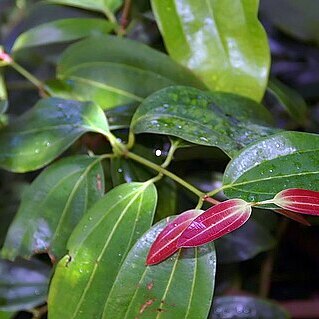Trees. Twigs usually ± pubescent (at least when young). Leaves opposite, or alternate or pseudowhorled, petiolate; lamina often triveined (at least near base). Inflorescence paniculate, axillary and pseudoterminal (Cinnamomum baileyanum axillary and terminal), not enclosed in hemispherical decussate bracts before anthesis. Flowers bisexual, 3-merous. Tepals 3 + 3. Stamens: anthers 6 introrse + 3 extrorse, 4-locular; glands 6, stalked, with stalks sericeous, heads glabrescent. Staminodes 3, differentiated; stalks sericeous; head ± sagittate. Ovary ± sessile; stigma cumuloid or funnel-shaped. Fruit seated in a cup surrounding lower part of fruit; mesocarp fleshy; endocarp thin. Seed: testa thin; radicle apical; cotyledons distinct, uniform in texture.
Trees or shrubs , evergreen. Bark gray [or brown], furrowed [or smooth]; bark and leaves often aromatic. Leaves alternate, infrequently opposite. Leaf blade with (1-)3 primary veins [or infrequently pinnately veined], papery to leathery; surfaces glabrous or variously pubescent; domatia frequently present. Inflorescences appearing when mature leaves are present, axillary, panicles. Flowers bisexual; tepals deciduous or persistent, white, green, or yellow, equal; stamens 9, anthers 4-locular, 4-valved (rarely with anthers of inner 3 stamens 2-locular), extrorse; staminodes 3, apex sagittate or cordate; ovary ovoid-ellipsoid. Drupe bluish black, nearly globose, seated in small cupule with entire single rim or tepals persistent.

